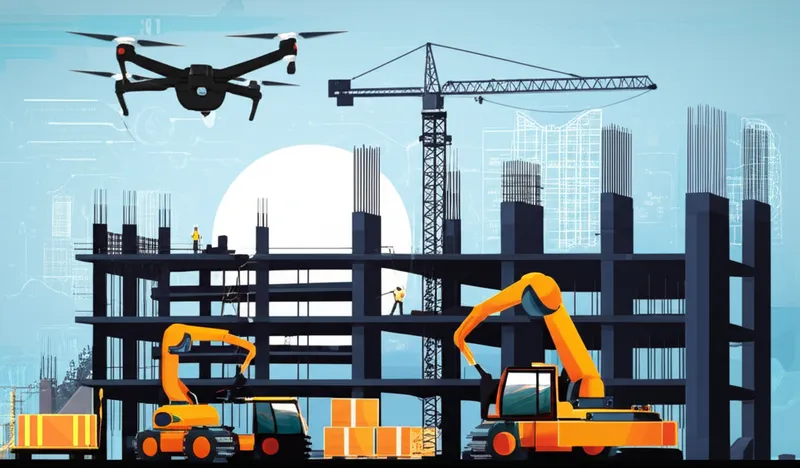How AI is Transforming Construction Safety

How AI is Transforming Construction Safety
Construction sites are inherently dangerous environments, with workers facing numerous hazards daily. However, artificial intelligence is revolutionizing how we approach safety in the construction industry, making job sites safer and more efficient than ever before.
The Current State of Construction Safety
Construction remains one of the most hazardous industries, accounting for a significant percentage of workplace injuries and fatalities. Traditional safety protocols, while important, are often reactive rather than proactive.
The statistics are sobering: construction workers are four times more likely to die on the job than workers in other industries. Common hazards include falls from height, struck-by objects, electrical hazards, and caught-in/between incidents. These “fatal four” account for more than half of all construction worker deaths.
AI-Powered Safety Solutions
Real-Time Hazard Detection
AI-powered cameras and sensors can now identify potential hazards in real-time, from workers not wearing proper PPE to unsafe working conditions. This immediate feedback allows for instant corrections before accidents occur.
Modern computer vision systems can:
- Detect missing hard hats, safety vests, or protective eyewear
- Identify unsafe behaviors like working too close to edges without fall protection
- Monitor equipment operation and flag dangerous situations
- Analyze worker posture and movement patterns to prevent ergonomic injuries
Predictive Analytics
By analyzing historical data and current conditions, AI can predict when and where accidents are most likely to occur, allowing project managers to take preventive measures.
These systems examine factors such as:
- Weather conditions and their impact on safety
- Worker fatigue levels and shift patterns
- Equipment maintenance schedules and failure predictions
- Site congestion and workflow inefficiencies
Automated Safety Monitoring
Machine learning algorithms can continuously monitor construction sites, tracking worker movements, equipment usage, and environmental conditions to ensure compliance with safety protocols.
Advanced monitoring systems provide:
- 24/7 surveillance without human fatigue
- Consistent application of safety standards
- Detailed documentation for compliance and training
- Immediate alerts for emergency response
Voice-First Communication in Safety
Traditional safety reporting often involves stopping work to fill out forms or make calls. Voice-first platforms like Conkoa are changing this by allowing workers to:
- Report safety concerns hands-free while continuing to work safely
- Receive immediate responses in their preferred language
- Access safety procedures through voice commands
- Participate in real-time safety discussions without language barriers
This seamless communication ensures that safety information flows quickly and accurately across diverse construction teams.
Case Studies in AI Safety Implementation
Large-Scale Infrastructure Projects
Major construction companies are already seeing dramatic results from AI safety implementations:
- Reduced incident rates: Some companies report 30-50% reductions in safety incidents after implementing AI monitoring
- Faster response times: Automated alert systems reduce emergency response times by up to 75%
- Improved compliance: Real-time monitoring ensures consistent adherence to safety protocols
Small to Medium Construction Companies
AI safety solutions are becoming more accessible to smaller contractors through:
- Cloud-based platforms that don’t require massive infrastructure investments
- Mobile apps that turn smartphones into safety monitoring devices
- Scalable solutions that grow with the business
The Future of AI in Construction Safety
As AI technology continues to advance, we can expect even more sophisticated safety solutions, including:
Wearable Technology Integration
- Smart helmets with built-in sensors and communication systems
- Wearable devices that monitor worker health and fatigue in real-time
- Augmented reality systems that overlay safety information on work environments
Advanced Predictive Capabilities
- Weather-integrated safety planning
- Predictive maintenance that prevents equipment-related accidents
- Advanced analytics that identify safety trends across multiple projects
Autonomous Safety Systems
- Drones for automated site inspection and hazard identification
- Robotic systems that can work in the most dangerous conditions
- Self-monitoring equipment that automatically shuts down when unsafe conditions are detected
Overcoming Implementation Challenges
While AI offers tremendous potential for improving construction safety, successful implementation requires addressing several key challenges:
Worker Acceptance and Training
- Comprehensive training programs to help workers understand and embrace new technology
- Clear communication about how AI enhances rather than replaces human judgment
- Involvement of workers in the selection and customization of AI safety tools
Data Privacy and Security
- Robust data protection measures to safeguard worker privacy
- Clear policies about data collection, storage, and usage
- Transparency about how AI systems make safety-related decisions
Integration with Existing Systems
- Seamless integration with current project management and safety systems
- Standardization across different projects and locations
- Scalable solutions that can adapt to various project sizes and types
Best Practices for AI Safety Implementation
Start with Clear Objectives
- Define specific safety goals and metrics
- Identify the most critical safety challenges on your projects
- Establish baseline measurements for improvement tracking
Choose the Right Technology Partners
- Select vendors with proven construction industry experience
- Ensure solutions can scale with your business growth
- Prioritize systems that integrate well with existing workflows
Focus on Worker Engagement
- Involve workers in the selection and testing process
- Provide comprehensive training and ongoing support
- Create feedback mechanisms for continuous improvement
Conclusion
The integration of AI in construction safety isn’t just about technology—it’s about creating a culture where safety is paramount and every worker returns home safely at the end of each day. By leveraging predictive analytics, real-time monitoring, and voice-first communication, construction companies can dramatically reduce accidents and create safer work environments.
The future of construction safety is intelligent, proactive, and collaborative. As AI technology continues to evolve, the construction industry has an unprecedented opportunity to transform workplace safety from reactive to predictive, creating safer jobsites for everyone.
The question isn’t whether AI will transform construction safety—it’s how quickly we can implement these life-saving technologies across the industry. The workers depending on us for their safety deserve nothing less than our best efforts to leverage every available tool to protect them.